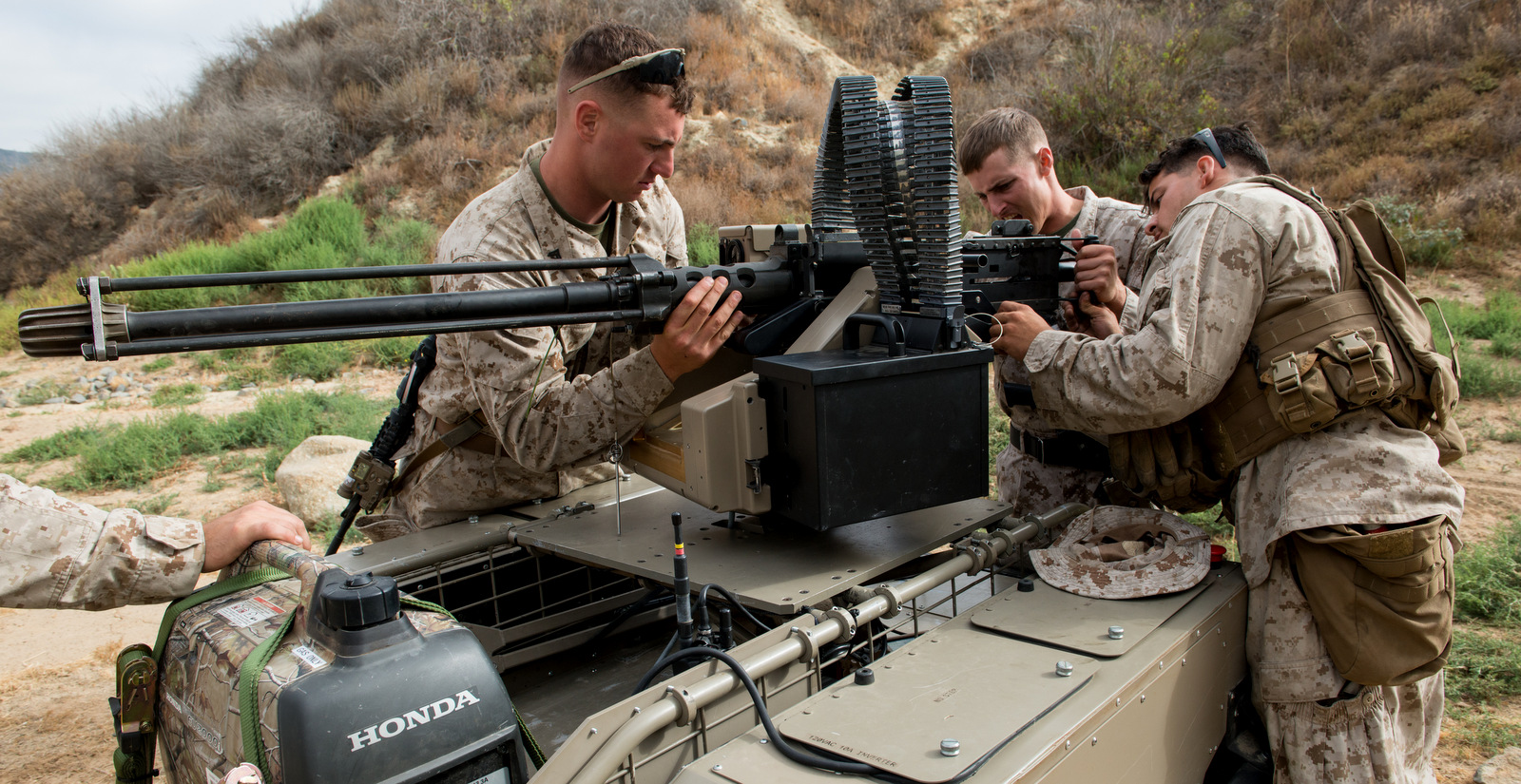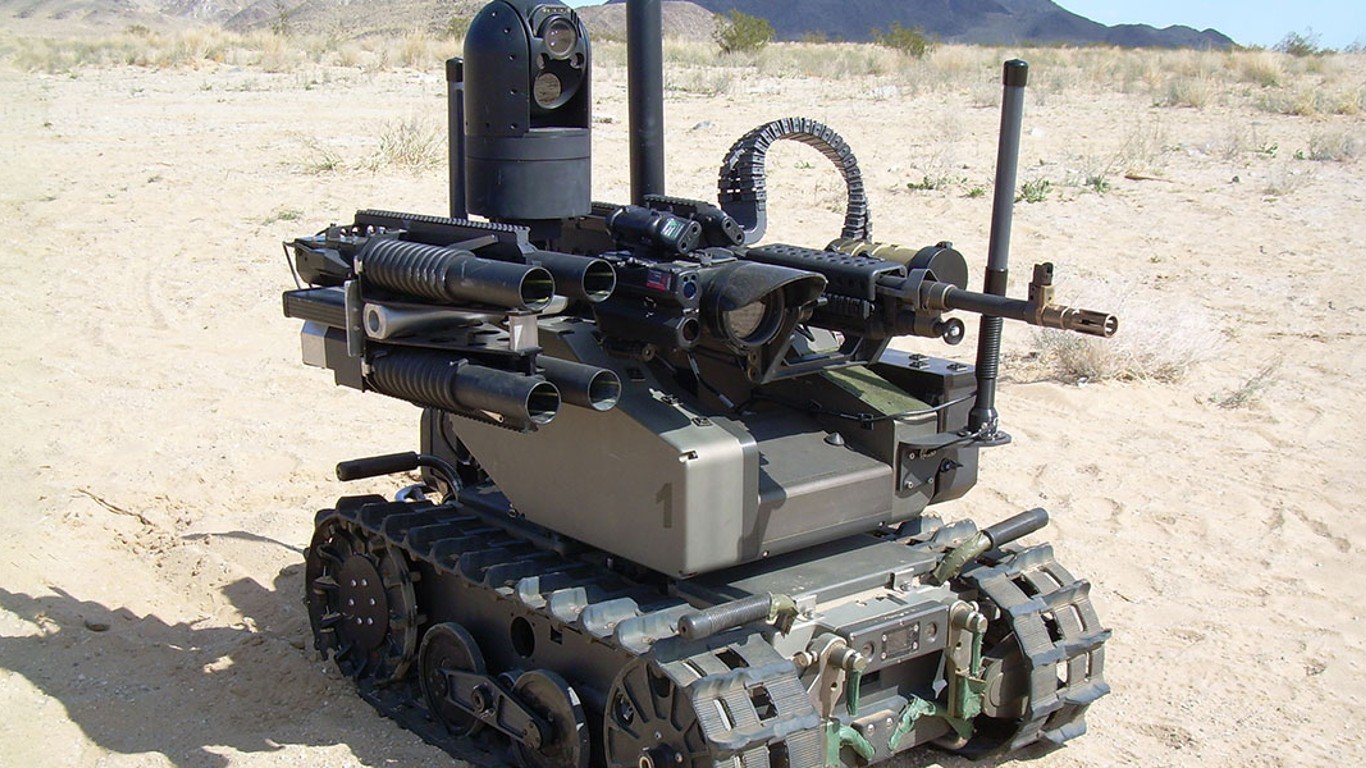Robot Military - Fort Detrick, Md. (Newswire, Nov. 22, 2010) -- Robots currently being tested may soon be able to save soldiers burned by fire without putting their lives at risk.
The Battlefield Evacuation Assist Robot, or BEAR, has been tested by soldiers for the past year at the US Infantry Center's Mobile Combat Laboratory at Fort Benning, Georgia.
Robot Military

BEAR can be controlled remotely using motion capture gloves or a specially equipped gun grip. Warfighters can use the device to guide a robot to rescue a wounded soldier and bring him or her back to where field medics can safely conduct an initial assessment.
Military Robots 2x2 Design Concept Royalty Free Vector Image
Medical Research and Materiel Command's Telemedicine and Advanced Technology Research Center (TATRC) helped fund the development of Vecna Technologies' humanoid BEAR and the integration of AnthroTronix's iGlove and M-4 rifle grip controllers into Fort Benning tests.
Gary Gilbert, who manages TATRC's medical robotics portfolio, said the Battle Lab's assessment provides a critical link between research and actual robots that can be used in the field.
"Our goal with the battle lab testing is to get the technology into the soldier's hands, whether through simulation or live exercises, and from their feedback derive the tactics, techniques and procedures appropriate to deploy it," Gilbert said. said.
"These [tactics, techniques and procedures] can then serve as the basis for developing actual operational capability needs and requirements," he said. "It's only when we know how we're going to use these technologies successfully that you're going to see them in the field."
Robotic Soldiers Are Absolutely Horrifying. Here's The Proof
BEAR's computer simulation was created in 2009 for use in Combat Lab's One Semi-Autonomous Force (OneSAF) combat operations simulator. OneSAF conducted a series of initial platoon-level assault and clearance operations in forested and urban terrain, including casualty evacuation using traditional litter rescue and BEAR rescue.
The AnthroTronix remote control system was integrated with the simulation in December 2009. In June, BEAR and AnthroTronix controllers underwent a field characterization study, where soldiers observed their capabilities in urban and forested terrain.
BEAR is a multimodal, high-degree-of-freedom robot that can reach and lift and carry up to 500 pounds with hydraulic arms; perform fine motor tasks with hands and fingers; maneuver with a double track system; stand up Keep your balance; and use your camera and sensors.

The robot gained national media attention when it was selected as one of Time magazine's 2006 Best Invention Awards. Subsequent versions improved its capabilities.
What Happens When Bomb Defusing Robots Become Weapons
While BEAR's initial control is via a remote human operator, more complex semi-autonomous behavior is being worked on in which the robot can understand and execute increasingly advanced commands.
The iGlove is a low-cost, universally compatible control device marketed as the AcceleGlove since 2009. The company plans to develop a new version with more accelerometers and a digital compass, so users can use only signals from the glove to instruct the robot to disable an IED or move exactly 300 meters west.
The Mounted Force Controller is another robotic control device that can be mounted on an M-4 rifle so soldiers can use it without putting down their weapon.
Noted AnthroTronix CTO Jack Vice said, "One of the most promising results from the combat lab simulations and field testing is that Soldiers can learn to operate both the iGlove and the MFC with minimal training. Furthermore, after combining the iGlove with traditional controllers When comparing, the fighters prefer the simplicity of iGlove mode switching, only having to reach out and touch the human joints to control the corresponding robot joints.
Indian Army To Deploy Hundreds Of Robots To Fight Terrorists In Kashmir
Vice added, "TATRC support allows us to fully integrate the controller with the joint architecture of the unmanned system software, gain valuable feedback from Soldiers, and develop new control methods as we integrate the controller with the high-grade -freedom robot, like bears."
For these projects, TATRC used funding from the Tank Vehicle Research Development and Engineering Command, the Joint Ground Robotics Enterprise, the Robotic Systems Joint Program Office, the Research Laboratory, the Small Business Innovation Research Program, and Congressional Directed Research Funding.
"The Battle Lab testing process has enormous potential to overcome the many barriers to turning a research prototype or emerging technology into an operational system," Gilbert said. "Even our initial simulations and field operational assessments indicate significant research challenges in the development and deployment of unmanned systems for combat casualty care. But this is the technology of the future."

"If a robot can be used against threats such as urban combat, booby-trapped IEDs, and chemical and biological weapons, it can save the lives of medical personnel and fellow soldiers," he said. uh, absolutely awful. Some students and faculty at Carnegie Mellon University were uneasy about a new military artificial intelligence research base on campus, and Google employees protested an AI project for the Pentagon.
How To Train Your Ai Soldier Robots (and The Humans Who Command Them)
Terminator: Dark Fate hits theaters this weekend, but the visuals may be even scarier thanks to some unsettling realism. Los Angeles-based production studio Corridor Digital, which specializes in visual effects, shot a wet-pants-level parody video of a future filled with robot soldiers without human intervention.
This robot is fast! It can shoot targets (while throwing large objects at them) with great precision! It can be pushed down by other soldiers, then chased after, with a gun to their chest! Can even withstand gunshots during a standstill!
This content was imported from YouTube. You can find the same content in other formats, or you can find more information on their website.
The parody is an obvious homage to Boston Dynamics, the Massachusetts-based robotics company that continues to make funny but creepy videos of the progress its robots make. There's Spot, a dog-like robot that the company can now hire, and there's a humanoid named Atlas, who's pretty scary in his own right, roaming the woods and doing parkour like a metal Slenderman.
Military Robot Android In The Desert Sur...
This isn't Corridor Digital's first foray into copying video. In June, the company released a video of a Boston Dynamics-like robot beating up people in a warehouse.
The problem is that people think the video is real and are completely off the mark. So Corridor released a behind-the-scenes video detailing how they rebuilt the Boston Dynamics robot and made the video (hint: lots and lots of CGI).
Before joining Pop Mech, Courtney was a technology reporter for her hometown newspaper, the Pittsburgh Post-Gazette. She graduated from the University of Pittsburgh with a major in English and Economics. Her favorite subjects include, but are not limited to: giant squid, punk rock, and robotics. She and her partner, her black cat, live in suburban Philadelphia on Book Tower.

This tiny jumping robot can repair itself in jumps Scientists turn dead spiders into creepy grippers 11 weird robots that will change the way we live Dyson's new robot will clean your house
Military Robots Perform Worse When Humans Won't Stop Interrupting Them
Watch This Tiny Remote Controlled Robot Crab Walk The Physics of Carrying Coffee Without Spilling Watch This Prosthetic Hand Win an Arm Push Contest. This 3D-printed fingertip helps robots 'feel'
China developed a 'robot yak' for ground troops, and now we have robot dogs with sniper rifles. The military wants to make a squirrel-inspired robot that can do parkour...but why? A four-legged robot with a gun was displayed at a meeting of the Association of the US Army
The robot, developed by Philadelphia-based Ghost Robotics, is a new version of its Vision line of legged robots. The US Air Force is currently testing unarmed versions of the robots at Tyndall Air Force Base in Florida for use as perimeter security.
Ghost Robotics demonstrated the weaponized version at the Association of the US Army's annual meeting in Washington this week. The robot is equipped with Sword Defense's dedicated unmanned gun pod, as well as a powerful 6.5mm sniper rifle. It has day and night cameras and an effective range of 1200 meters.
Why There's A Growing Push To Ban Killer Robots
Ghost Robotics has been developing the four-legged robot since 2015, and previously showed a version equipped with add-ons, including arms to defuse bombs and a jammer, a shotgun-like bomb device.
These robots are highly mobile, capable of traversing rough terrain that can be difficult for wheeled and tracked machines, and can operate with a high degree of autonomy. For example, a perimeter patrol robot is able to follow a predetermined route, deviate if necessary to avoid obstacles, and alert operators when they encounter unexpected situations such as possible intruders.
However, Ghost Robotics CEO Jiren Parikh was quick to dismiss any notion that the sniper rifle was an autonomous weapon system.

"It's completely controlled by a remote operator," Parikh said. "Humans control the weapons, there is no autonomy or artificial intelligence."
D Military Two Legged Robots In Four Projections Vector Image
He said the robot was
Walking military robot, japan military robot, litter robot military discount, boston dynamics military robot, robot dogs military, military robot companies, lego military robot, military surveillance robot, robot suit military, robot for military application, future military robot, military robot movie
0 Comments